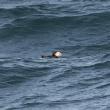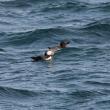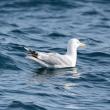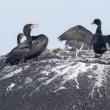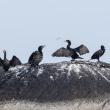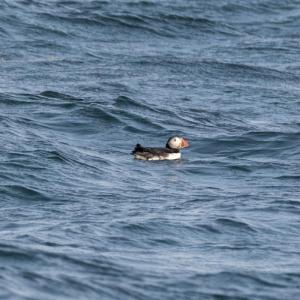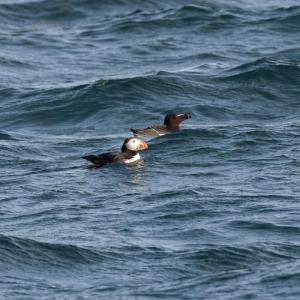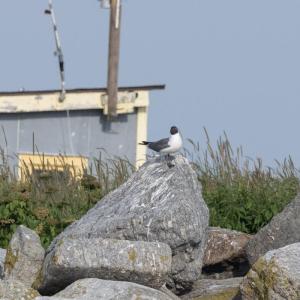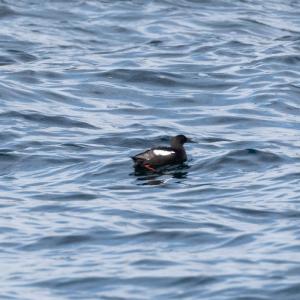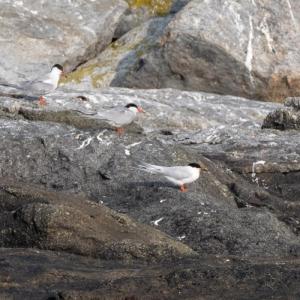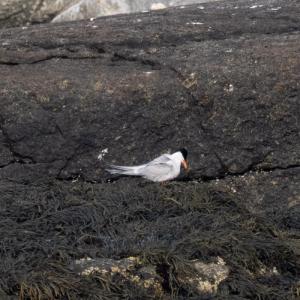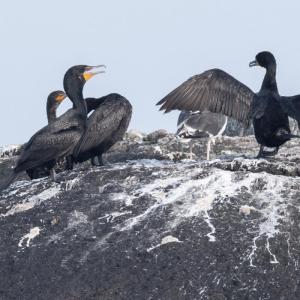Maine Audubon Sunset Puffin Cruise
Eastern Egg Rock is a remarkable place, known for being the first restored seabird colony in the world (https://www.audubon.org/conservation/project/project-puffin). Eastern Egg Rock is about six miles off the coast of New Harbor, Maine. In 1973, Stephen Kress learned that puffins had been finally pushed away from their nesting colony on Eastern Egg Rock in 1885 after years of hunting and trapping. Inspired, he decided to bring the puffins back. Over the course of many years, Stephen Kress and Maine Audubon relocated nearly 1,000 ten day old chicks from a thriving puffin colony in Nova Scotia to Eastern Egg Rock. The Maine Audubon team fed the chicks by hand, in hopes that the birds would return when they were mature enough to nest on the island.
In 1981, the puffins were back for the first time in nearly a century, with five nesting pairs! The number of nesting pairs began to climb, and in 2017, there were 172 nesting pairs. Project Puffin continued to bring the puffins back, and there are now more than 1,000 nesting puffin pairs on three islands in Maine. This was a revolutionary process, and is now being used to restore seabird colonies and try to save endangered ones all over the world. Project Puffin also restored terns to the island, and today there are over 1,000 nesting pairs on Eastern Egg Rock. There are also biologists on the island from May to August monitoring the puffins and other nesting birds.
On July 19, 2020, my family and I boarded the boat that would take us to Eastern Egg Rock. The cruise was narrated by Doug Hitchcox, run by Maine Audubon, and the boat was provided by Hardy Boat Cruises. Masks were required at all times, social distancing was enforced, and the boat was at half capacity. Laughing Gulls circled the dock as we left, starting the cruise off well. The ride out to the island was uneventful, but we did see some Double-Crested Cormorants and Great Black-backed Gulls. Once we got to the island, everything picked up. There were birds everywhere, calling and flying. Luckily, Doug was a fantastic narrator and told us where everything was that we needed to see. We partially circled the island once, and saw thirteen different species! We did see Atlantic Puffins right away, but the spotlight of the cruise ending up being on the surprise Razorbill that took two circles around the island. We also saw Common Eiders, Common, Arctic, and Roseate Terns, Semipalmated Plovers, Spotted Sandpipers, a Ruddy Turnstone, Laughing and Herring Gulls, and Black Guillemots. Overall, we ended up seeing 850 individuals (https://ebird.org/checklist/S71694000). Not a bad way to spend a gorgeous summer day in Maine!
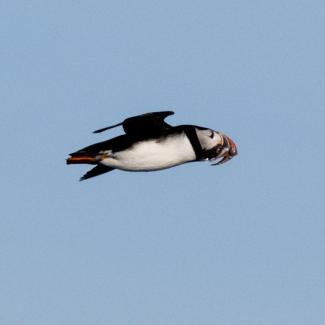 An Atlantic Puffin carrying a fish, possibly to a chick. Photo courtesy Jim Nickelson.
An Atlantic Puffin carrying a fish, possibly to a chick. Photo courtesy Jim Nickelson.
 An Atlantic puffin flying. Photo courtesy Jim Nickelson.
An Atlantic puffin flying. Photo courtesy Jim Nickelson.
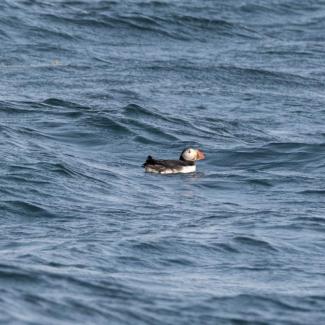 An Atlantic Puffin swimming. Photo courtesy Jim Nickelson.
An Atlantic Puffin swimming. Photo courtesy Jim Nickelson.
 An Atlantic Puffin swimming. Photo courtesy Jim Nickelson.
An Atlantic Puffin swimming. Photo courtesy Jim Nickelson.
 An Atlantic Puffin swimming with a Razorbill. Photo courtesy Jim Nickelson.
An Atlantic Puffin swimming with a Razorbill. Photo courtesy Jim Nickelson.
 A Laughing Gull watching all of the action. Photo courtesy Jim Nickelson.
A Laughing Gull watching all of the action. Photo courtesy Jim Nickelson.
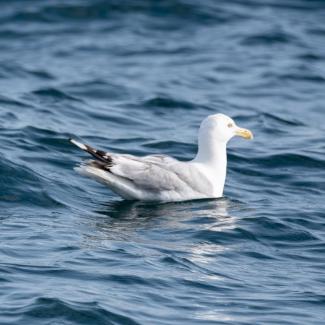 A Herring Gull swimming. Photo courtesy Jim Nickelson.
A Herring Gull swimming. Photo courtesy Jim Nickelson.
 A Black Guillemot swimming. Photo courtesy Jim Nickelson.
A Black Guillemot swimming. Photo courtesy Jim Nickelson.
 A Black Guillemot flying. Photo courtesy Jim Nickelson.
A Black Guillemot flying. Photo courtesy Jim Nickelson.
 A Black Guillemot swimming. Photo courtesy Jim Nickelson.
A Black Guillemot swimming. Photo courtesy Jim Nickelson.
 Common and Roseate Terns. The only Roseate Tern in this photo is the rightmost bird. Photo courtesy Jim Nickelson.
Common and Roseate Terns. The only Roseate Tern in this photo is the rightmost bird. Photo courtesy Jim Nickelson.
 Common and Roseate Terns. The only Roseate Tern in this photo is the rightmost bird. Photo courtesy Jim Nickelson.
Common and Roseate Terns. The only Roseate Tern in this photo is the rightmost bird. Photo courtesy Jim Nickelson.
 Common and Roseate Terns. The only Roseate Tern in this photo is the rightmost bird. Photo courtesy Jim Nickelson.
Common and Roseate Terns. The only Roseate Tern in this photo is the rightmost bird. Photo courtesy Jim Nickelson.
 Two female Common Eiders. Photo courtesy Jim Nickelson.
Two female Common Eiders. Photo courtesy Jim Nickelson.
 A Common Tern. Photo courtesy Jim Nickelson.
A Common Tern. Photo courtesy Jim Nickelson.
 Double-crested Cormorants warming up. Photo courtesy Jim Nickelson.
Double-crested Cormorants warming up. Photo courtesy Jim Nickelson.
 Double-crested Cormorants warming up. Photo courtesy Jim Nickelson.
Double-crested Cormorants warming up. Photo courtesy Jim Nickelson.
 Double-crested Cormorants warming up. Photo courtesy Jim Nickelson.
Double-crested Cormorants warming up. Photo courtesy Jim Nickelson.
 A flock of various species. This was one of the smallest flocks we saw. Photo courtesy Jim Nickelson.
A flock of various species. This was one of the smallest flocks we saw. Photo courtesy Jim Nickelson.
United States





